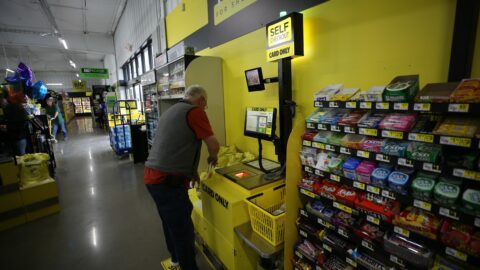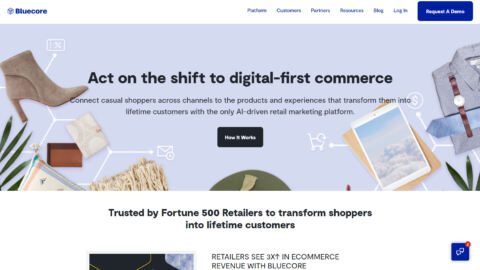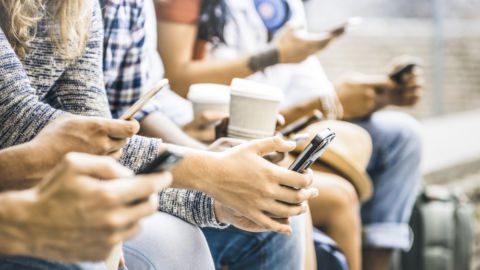Following is Part 1 of a 2-part feature examining the role of mobility in the in-store customer journey. This section looks at the first steps of that journey, with supporting comments from Walmart and several analysts. Part 2 reviews the last few stages of the mobile-influenced in-store experience ― including “behind the scenes” activities such as mobile RFID. Part 2 will appear in the October 29 newsletter.
The in-store experience has become so permeated with mobile enhancements that brick-and-mortar shopping looks more like an online experience every day. These enhancements include pre-shopping research, geo apps, advanced on-floor assistance, mobile RFID, mPOS and other mobile-delivered capabilities.
A report from Deloitte Consulting, entitled The Dawn Of Mobile Influence, noted that in retail stores, the next few years “are going to be huge for mobile. Its influence is anticipated to grow exponentially to 17% to 21% of total retail sales, amounting to $628 billion to $752 billion in mobile-influenced store sales by 2016.”
The fact that mobility now offers expanded brick-and-mortar retail opportunities is paradoxical: This new potential “largely is driven by what was once perceived as a threat to [the brick-and-mortar] traditional business model: new technology,” indicated the KPMG 2013 Retail Industry Survey Outlook. “In fact, technology is providing brick-and-mortar retailers with innovative ways to seize strategic opportunities. With technology continuing to advance at warp speed, novel approaches seem limited only by the imagination, and many brick-and-mortar stores already have let their creativity take hold.”
Mobile For Pre-Shopping Grows
As many as 90% of mobile-equipped customers used their devices for pre-shopping activities, according to a study, entitled: Mobile In-Store Research: How In-Store Shoppers Are Using Mobile Devices, conducted by the Google Shopper Marketing Council. The report found that 52% of this group consulted their mobile devices for store-related shopping while on their way to the store; 45% did so one day or the night before the trip; and 37% also did so from two to seven days prior to in-store shopping.
Before stepping foot into a Walmart store, most customers “use our iPhone, iPad or Android apps to look up store hours, locations and directions; create shopping lists by either speaking into the phone or entering the items; find coupons; and/or review the local ad for that store,” said Ravi Raj, VP of Mobile Products for Walmart, in an interview with Retail TouchPoints. “In-store shoppers also can search for products online; examine specifications, prices, and ratings and reviews; and buy products online or check for availability at a store nearby.”
Renault uses a different twist on educating and enticing customers prior to their onsite visit. The luxury automobile manufacturer draws prospective customers with an interactive brand magazine available on smartphones and tablets, as reported in a recent article by Retail TouchPoints. Prior to visiting the dealer, mobile app users can learn how a vehicle was developed, and view professional product videos, photos, lifestyle interviews and more. Users also are urged to share their points of interest. “Once prospects enter a dealership, a salesman is able to look up their information,” stated Philippe Reynaud, Head of Mobile Devices at Renault, “and instantly provide the information they’re seeking.” Earlier this summer, the app already had been downloaded 15,300 times.
Once in a store, mobile-equipped consumers use their smartphones and tablets to find digital coupons and promotions, purchase discount deals, compare prices and more.
In September 2013, Best Buy introduced the “My Best Buy” loyalty program, which includes a new mobile check-in feature. Members receive bonus points for using their mobile devices to check in with the app as they enter stores. Users also receive special promotions offered via the mobile program.
Location-Based Marketing Makes Inroads
More retailers are considering location-based marketing as a way to better target individual consumers. “Location-based offers are the future, but they demand a central point of validation for a consumer opt-in,” noted Ian Michiels, Principal and Managing Director of Gleanster Research. “The hurdle that must be overcome is some kind of centralized mobile brand exchange where users can manage preferences for the brands they want most.”
Walmart has moved full-force into geo-fencing for location-based marketing. Walmart shoppers armed with the branded app are invited to switch to “store mode” when they enter one of the 4,000 U.S. Walmart stores — all now digitally geo-fenced. If customers have created a shopping list on their devices, “the app shows them in which aisles products are located, along with local prices of products in that specific store,” Raj reported. “Walmart was the first major retailer to introduce ‘store mode’ across the entire chain.”
More than 50% of Walmart customers have smartphones, added Raj. As mobile devices become more ubiquitous in the brick-and-mortar environment, “our mobile apps will continue to improve the in-store experience for Walmart customers. Our engineers currently are working on new features, which, when launched, will delight our store shoppers.”
Location-based awareness of a mobile device, such as a geo-fencing application, creates “all kinds of interesting opportunities for consumer engagement use cases,” said Chris Cox, VP of Product Development for Mobile Solutions at First Data, a global payment processing company, in a Retail TouchPoints feature covering mobile payments.
Mobile use in-store also has facilitated showrooming, once the bane of brick-and-mortar retailers. But today merchants are taking steps to embrace showrooming, according to the Google Mobile In-Store Research report: Retailers also are improving the in-store experience with interactive product demos and more expert service from salespeople. (For more information on this topic, be on the lookout for the Retail TouchPoints Showrooming feature scheduled to appear in the November 12 newsletter.)
The Importance Of Store Associate Access To Mobile
Instant access to Internet data via mobile isn’t just a shopper benefit: Mobile-equipped store associates can literally become human help desks. With just a few clicks, associates can check product pricing, locate products in-store or within the chain, cross- and up-sell, and more. “Associates can even issue a coupon on the spot in order to close the sale ― an especially useful tactic if a price comparison has taken place,” said Jeff Feinberg, Managing Director of Alvarez & Marsal Private Equity Services. “The pure convenience of leaving with the item provides the motivation of instant gratification for shoppers.”
Mobile-enhanced selling also is key to the multichannel approach of “order online, pick up in-store,” Feinberg added, “When a consumer enters the store to acquire the order, “an associate with a mobile device in hand can check on that the order as well as the shopper’s buying history and preferences. He or she can then suggest complementary products, accompany the shopper to the products’ various locations, and have them pay, on the spot. This fast, targeted, flexible and helpful strategy allows retailers to develop better and deeper relationships with their customers.”
On the flip side, mobile also can eliminate the need for store-level sales staff. Hointer, a men’s jeans brand, has stores “with virtually no salespeople,” wrote Deena Amato-McCoy, Retail and Banking Research Analyst for Aberdeen, in a July 2013 blog. Each pair of jeans hanging in these Hointer stores is tagged with a QR code. When customers enter a store, “signage prompts shoppers to download a mobile phone app for iPhones and Android devices. The app allows them to scan QR tags on merchandise, and select their size. Then the app directs them to a fitting room where choices are already waiting for them. (This happens thanks to dedicated fulfillment equipment residing in the storeroom that picks and delivers customers’ choices.) Consumers can check out right from dressing rooms, if they choose. Don’t have a smart phone that supports the app? No problem. Hointer has loaners available.”
However, many in-store shoppers still appreciate help from an expert sales staff. “There are times when human interaction is not only welcome, but a mission critical strategy needed to personalize the shopping experience and differentiate your brand from the clutter in the marketplace,” noted Amato-McCoy. “The best way to achieve this: arm knowledgeable associates with automation to bring the store-level experience to the next level.”
Today, mobile is retailers’ automation device of choice for helping associates enhance the store experience. For both customer-facing applications and those behind the scenes, including mobile RFID for inventory management, mobility in the in-store customer journey continues to bring online experiences to offline retail.
Part 2 of The Mobile-Influenced In-Store Experience will appear in the October 29 newsletter.












